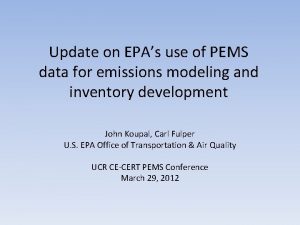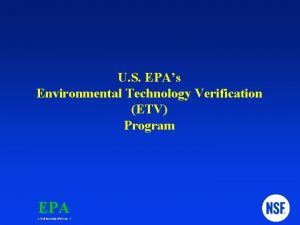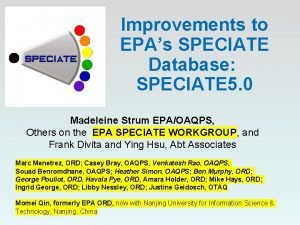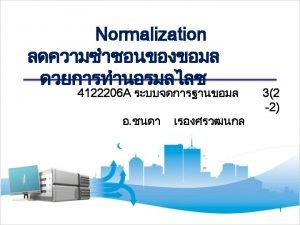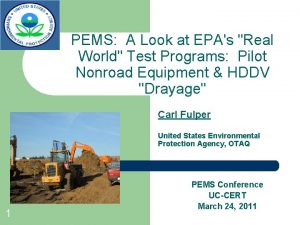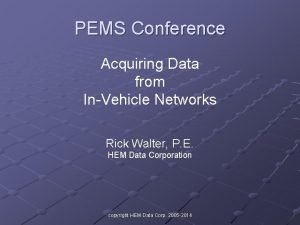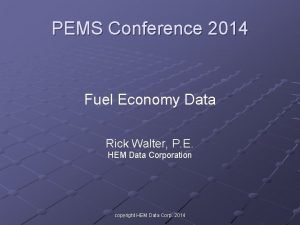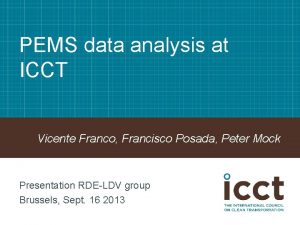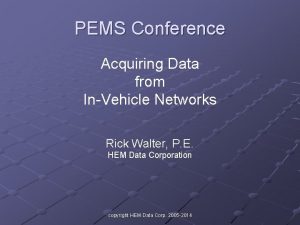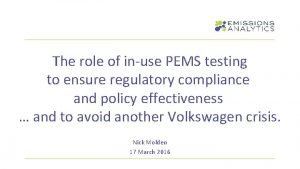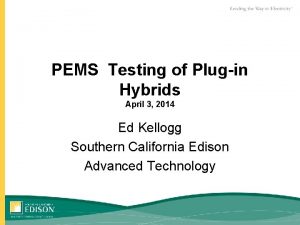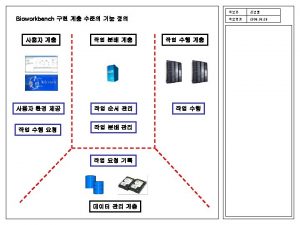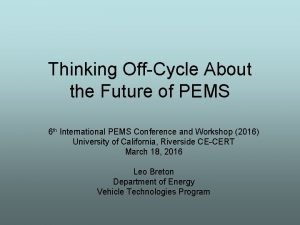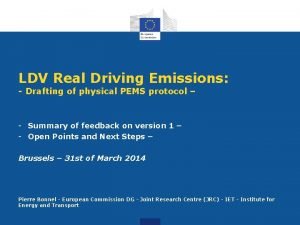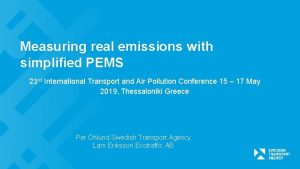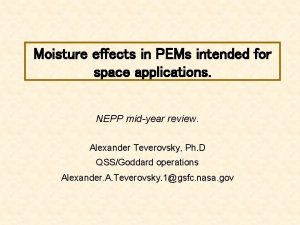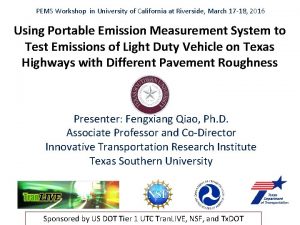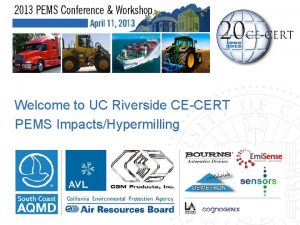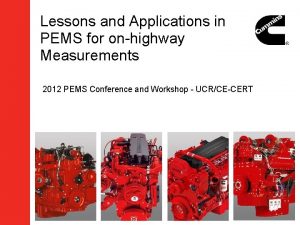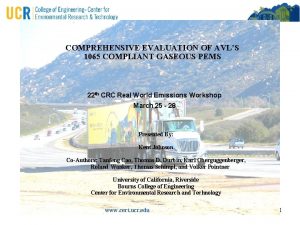Update on EPAs use of PEMS data for





















- Slides: 21

Update on EPA’s use of PEMS data for emissions modeling and inventory development John Koupal, Carl Fulper U. S. EPA Office of Transportation & Air Quality UCR CE-CERT PEMS Conference March 29, 2012

EPA PEMS Emission Factor Programs • MOVES “Shootout” (2001) • Kansas City LD PM program (2005) • Diesel Construction “Pilot” program (2008) • Evaporative Field Leak program (2009 -11) • Houston HD “Drayage” program (2010) • Tier 2 LD program (2012) 2

Houston Port Dray Truck Study • Collected emissions and activity data on HD drayage trucks using PEMS and PAMS in 2009 -10 • Trucks selected for PEMS testing based on RSD scores • Generally higher mileage (> useful life) Model Year Number of Trucks w/ PEMS 1989 and prior 1 1990 - 1991 -1997 10 1998 3 1999 -2002 13 2003 -2006 10 3

Prelim Houston Drayage PM Results Individual Trucks by Model Year 4

In-use compliance data & MOVES • Heavy-duty in-use compliance data collected by manufacturers is also being analyzed to help update MOVES heavy-duty emission estimates Number of Trucks Analyzed MY HHD MHD LHD 2005 35 15 10 2006 25 18 5 2007 21 2008† 16 10 - 2009 22 36 4 † excludes vehicles using AB & T for HHD 5

NOx Results for Common Engine Family 1 - 25 mph 25 - 50 mph 3000 HDIUD Drayage MOVES HHD NOx (g/hr) 2500 2000 1500 1000 500 0 1 11 12 13 14 15 16 21 22 23 24 25 27 28 29 30 33 35 37 38 39 40 op. Mode. ID 6

NOx Maps for Common Engine Family Houston Drayage 5 yrs old, 750 K miles Compliance Program 2 yrs old, 350 K miles 7

Tier 2 Light Duty Program • Objective: emission factors for Tier 2 vehicles – Long term goal is longitudinal study, multiple cities • Screening component (RSD) – Facilitating representative recruitment • Capturing “dirty vehicles” – Serves as independent measure • Measurement component – Portable emissions measurement systems • Pilot Study – – RSD conducted in 2010; PEMS component 2012 Detroit metro statistical area Develop, test and refine screening indices Develop and field-test methods 8

In-Use Deterioration over Ten Year Period LDV Data Source from AZ I/M & Aggregate IM 147 Need to characterize for newer vehicles 9

Why Screen? Attempting to capture the entire distribution

Pilot: Research Questions • Can we use Remote Sensing to – screen emissions level for vehicles – Ranging from clean to dirty – With some degree of reliability? • How can we measure starts using PEMS? • How can we recruit/retain participants? – Short term? – Long term? • Can we compensate for non-response bias? – Using the screening measurements? 11

Study Population/Area – Privately-owned lightduty vehicles Primary + Secondary = Consolidated MSA • Tier 2 -Bin 5 / LEV-II – Study Area • Detroit Metropolitan Statistical Area – Primary » Lapeer » Macomb » Monroe » Oakland » St. Clair – Secondary » Lenawee » Livingston » Washtenaw “Primary” MSA “Secondary” MSA 12

What to Measure? Emissions: The usual suspects Constituent Basis Technique ----------------------------------------CO 2 continuous Eco. Star HC/CO/NOx continuous Eco. Star PM aggregate 47 mm filters PM continuous? Pressure Transducer? May correlate to AVL Microsoot Sensor? 13

Activity Measurements Parameter Basis Technique ----------------------------------------Basic Diagnostic trouble codes Fuel control status (closed, open loop) Engine-coolant temperature Intake air temperature Instruments: Manifold air temperature HEM Data: OBD Mini. Logger w/ GPS Air flow rate Engine speed Calculated load Vehicle speed Other parameters (to be determined) “Enhanced” Air-conditioning code O 2 sensor(s) Air/fuel ratio Ambient temperature GPS Measurement Period: ~ two weeks 14

PAMS Devices OBD Logger Current HEM Data Devices GPS Unit New HEM Data Devices w/ integrated GPS

What kind of Operation? “put the vehicle thru its paces” – On pre-arranged drive route – – – – – Start (cold and warm) parking lot, residential, arterial, on-ramp, freeway, off-ramp, Idle, Grade (hills) – “load” – Get starts (with PEMS) – Run, soak, repeat – In-use version of FTP Bag 1, Bag 3, etc. 16

Driving Routes “Cold” & “Hot” Start Filter #1 Driving Filter #2 includes hills “load” Idle Filter #3

Logistics: Emissions (“Quick vehicle turn around”) URS EPA URS 18

• • • Vehicle Setup Sensor’s Eco. Star unit 3 PM filters Proportional Sampling 2 Marine Deep Cell Batteries GPS Ambient Air Sensor Flow Meter Vehicle Interface Laptop Computer Equipment Weight: 150 lbs

• Change in HC can be seen at medium to high Accels < 25 mph 25 - 50 mph > 50 mph

Summary • EPA is actively using PEMS to conduct emission factor testing • Data will inform EPA models and inventories • Have conducted program for LD, HD and Nonroad sectors • Have begun using RSD as selection device for PEMS testing • Piloting LD recruitment / testing methodology in Detroit area this year – Using prescribed drive route approach for PEMS 21
 Pems emissions modeling
Pems emissions modeling Epas
Epas Epas enablers
Epas enablers Epas technologies
Epas technologies Jonas radvanas
Jonas radvanas Epas database
Epas database Which is an alternative of log based recovery
Which is an alternative of log based recovery Dokumen deskripsi sdmk
Dokumen deskripsi sdmk Data redundancy and update anomalies
Data redundancy and update anomalies Iso 22301 utbildning
Iso 22301 utbildning Typiska novell drag
Typiska novell drag Tack för att ni lyssnade bild
Tack för att ni lyssnade bild Returpilarna
Returpilarna Varför kallas perioden 1918-1939 för mellankrigstiden?
Varför kallas perioden 1918-1939 för mellankrigstiden? En lathund för arbete med kontinuitetshantering
En lathund för arbete med kontinuitetshantering Kassaregister ideell förening
Kassaregister ideell förening Personlig tidbok för yrkesförare
Personlig tidbok för yrkesförare A gastrica
A gastrica Förklara densitet för barn
Förklara densitet för barn Datorkunskap för nybörjare
Datorkunskap för nybörjare Tack för att ni lyssnade bild
Tack för att ni lyssnade bild Mall debattartikel
Mall debattartikel
